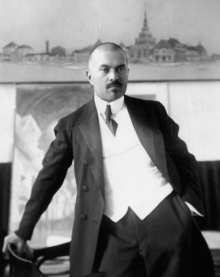
Back أليكسي شيوسيف Arabic اليكسى شتشوسيڤ ARZ Аляксей Віктаравіч Шчусеў Byelorussian Алексей Шчусев Bulgarian Aleksei Sxússev Catalan Alexej Ščusev Czech Щусев Алексей Викторович CV Alexei Wiktorowitsch Schtschussew German Αλεξέι Σιούσεφ Greek Alekséi Shchúsev Spanish
Alexey Shchusev | |
|---|---|
 Shchusev in 1914 | |
| Born | 8 October 1873 |
| Died | 24 May 1949 (aged 75) |
| Alma mater | Imperial Academy of Arts |
| Occupation | Architect |
| Awards | Stalin Prize (1940, 1946, 1948, 1952) |
| Practice |
|
Alexey Victorovich Shchusev[a] (Russian: Алексей Викторович Щусев; 8 October [O.S. 26 September] 1873 – 24 May 1949) was a Russian and Soviet architect who was successful during three consecutive epochs of Russian architecture – Art Nouveau (broadly construed), Constructivism, and Stalinist architecture,[2] being one of the few Russian architects to be celebrated under both the Romanovs and the communists, becoming the most decorated architect in terms of Stalin prizes awarded.[3]
In the 1900s, Shchusev established himself as a church architect, and developed his proto-modernist style, which blended Art Nouveau with Russian Revival architecture. Immediately before and during World War I he designed and built railway stations for the von Meck family, notably the Kazansky Rail Terminal in Moscow. After the October Revolution, Shchusev pragmatically supported the Bolsheviks, and was rewarded with the contract for the Lenin Mausoleum. He consecutively designed and built three mausoleums, two temporary and one permanent, and supervised the latter's further expansion in the 1940s. In the 1920s and early 1930s he successfully embraced Constructivist architecture, but quickly reverted to historicism when the government deemed modernism inappropriate for the Communist state.
His career proceeded smoothly until September 1937, when, after a brief public smear campaign, Shchusev lost all his executive positions and design contracts, and was effectively banished from architectural practice. Modern Russian historians of art agree that the charges of professional dishonesty, plagiarism, and exploitation raised against Shchusev were, for the most part, justified. In the following years he gradually returned to practice, and restored his public image as the patriarch of Stalinist architecture. The causes of his downfall and the forces behind his subsequent recovery remain unknown.
- ^ Chmelnizki 2021, p. 4.
- ^ Chmelnizki 2021, p. 78.
- ^ "Alexei Shchusev (Șciusev) (1873–1949) | Chisinau". Visit Chișinău. Retrieved 2 October 2023.
Cite error: There are <ref group=lower-alpha> tags or {{efn}} templates on this page, but the references will not show without a {{reflist|group=lower-alpha}} template or {{notelist}} template (see the help page).
© MMXXIII Rich X Search. We shall prevail. All rights reserved. Rich X Search